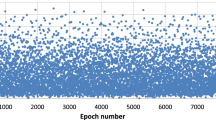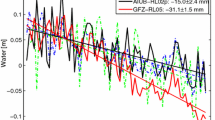Summary
Given an analytical solution (solution of the equations of motion using analytical integration techniques) an integration of the variational equations is not necessary but simply a differentiation of the analytical solution. Based on a high-precision analytical solution explicit expressions for the coefficients of the observation equations to improve state variables and force model parameters have been derived.
The definition of suitable unknowns for a pure dynamic orbital improvement can be based then on an analysis of the information content of the data at hand by using those expressions.
Regarding the Fourier series structure of orbital perturbations as well as the special properties of crossover difference data, the proposed technique is particularly favourable for an evaluation of Remote Sensing Data such as altimeter, SST and gradiometer data from satellites in repeating orbits.
After a general discussion of the observation equations for crossover data our present results using GEOSAT altimeter data are discussed as one example for applications. Some short remarks about further applications are given.
Similar content being viewed by others
References
Brouwer, D., Clemence, G. M.:Methods of Celestial Mechanics, Academic Press, New York and London, 1961
Cui, Ch.: Die Bewegung Künstlicher Satelliten im Anisotropen Gravitationsfeld einer Gleichmäßig Rotierenden Starren Modellerde,DGK ReiheC-357, 1990, München
Cui, Ch., Mareyen, M.: Gauss's equation of motion in terms of Hill variables and first application to numerical integration of satellite orbits.Manuscripta Geodetica, 17:155–163, 1992
Hamming, R. W.:Numerical Methods for Scientists and Engineers. Dover Publications, New York, 1986
Moore, P., Rothwell, D.A.: A study of gravitational and non-gravitational modelling errors in crossover differences,Manuscripta Geodetica, 15:187–206, 1990
Sandwell, D.T, Milbert, D.G. and Douglas, B.C.: Global Nondynamic Orbit Improvement for Altimetric Satellites,J. Geophys. Res., 91, No. B9, 1986
Schwintzer, P., Reigber, Ch., Bode, A., Kang, Z., Zhu, S. Y., Massmann, F.-H., Raimondo, J. C., Binancale, R., Balmino, G., Lemoine, J. M., Moynot, B., Morty, J. C., Borlier, F., Boudou, Y.: Improvement of Global Gravity Field Modelling for ERS-1. Proc. 2. ERS-1 Symp., Hamburg, 1993
Author information
Authors and Affiliations
Rights and permissions
About this article
Cite this article
Cui, C., Lelgemann, D. Analytical dynamic orbit improvement for the evaluation of geodetic-geodynamic satellite data. Journal of Geodesy 70, 83–97 (1995). https://doi.org/10.1007/BF00863420
Received:
Accepted:
Issue Date:
DOI: https://doi.org/10.1007/BF00863420




